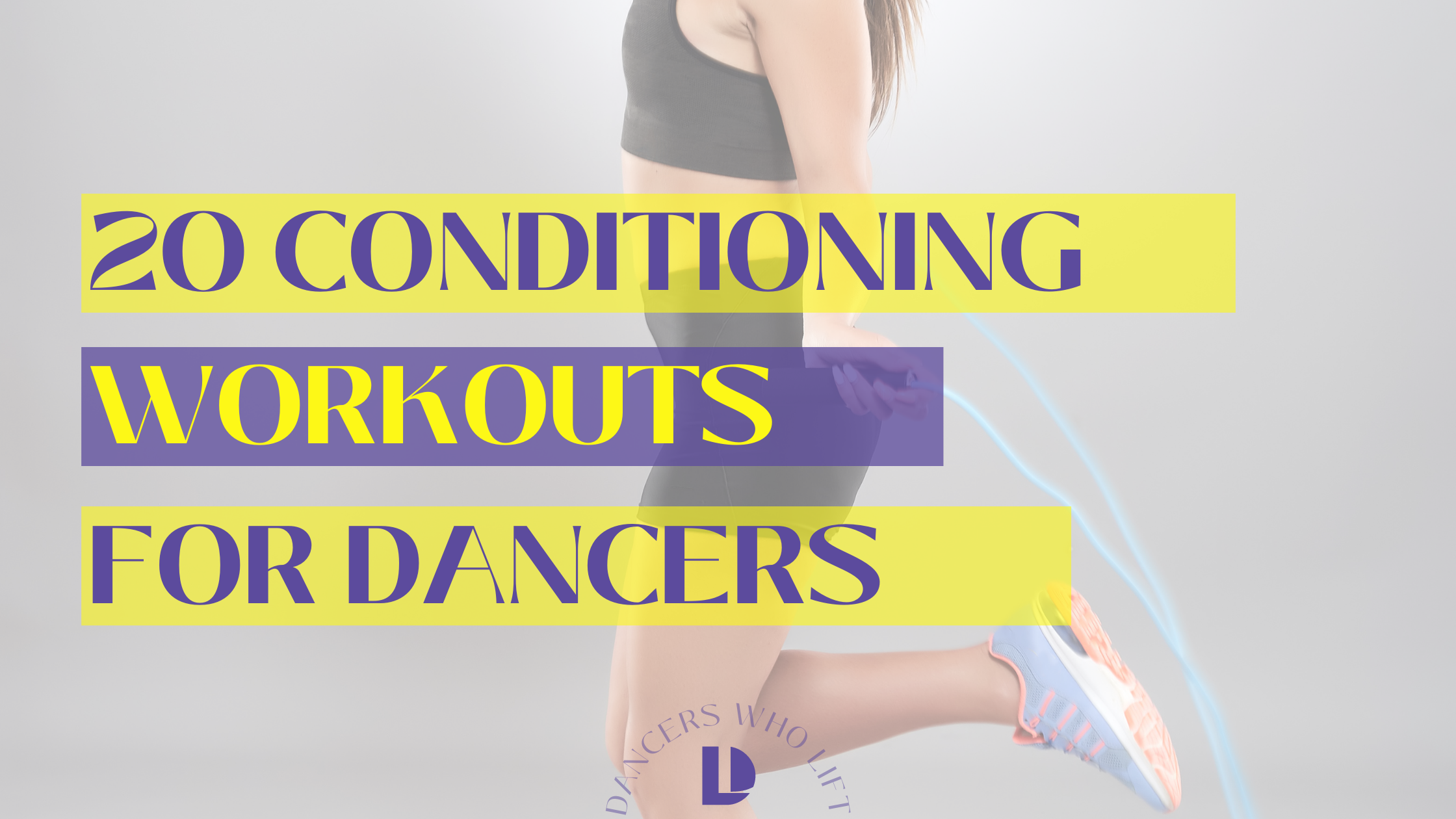I want to preface that this article about conditioning workouts is written in outrage. Or rather, irritation.
With whom? Well, not at anyone specifically, but just in general, Over this misconception that “conditioning” workouts for dancers look like tuck jumps and burpees.
Seriously, if you do a .5 second search, you’ll find:
- Burpees, squat jumps, and reverse lunge to skips
- 8 minute abs. A variation of crunches in every position, v-sits, and boat pose
- Some monster-mash hybrid move of a dancer balancing on a Bosu ball in a full penché while doing tricep kickbacks with 2 pound Bala bands…
- Run a dance… then run the dance again… then again… then, oh the dancer has melted into a puddle on the floor? Better do some squats, push-ups, and planks before, you guessed it, running the number one more time.
WHY GOD, WHY?!
So, before I share 20 Conditioning Workouts for Dancers, let’s define what conditioning is and, more importantly, what it is not.
So What is Conditioning?
DEFINITION:
Conditioning is a process in which stimuli are created by an exercise program performed by the athlete to produce a higher level of function.
GOAL:
The goal of conditioning is to optimize the performance of the athlete and minimize the risk of injury and illness.” (1)
In simple terms, conditioning workouts create an environment where the dancer or athlete is stimulated (challenged) to perform a higher level of function with the intended outcome of improved performance and reduced risk.
In even simpler terms: Move better, risk less.
This means, conditioning is NOT working out with the intention of getting sweaty and getting tired.
It also means conditioning workouts should be thoughtful, intentional, targeted training.
Most good conditioning workouts for dancers, like the ones you’ll see below, emphasize:
-Improvement on specific skills (height of a jump, length of a jump, quickness of an action)
-Improved cardiovascular recovery time. I.e. helping an athletic artist lower their respiratory rate quickly.
Should you choose to implement conditioning training into your own or your dancer’s routines:
Conditioning workouts for dancers, when done properly, take a big metabolic toll on a person.
This means, they require a ton of additional energy.
The conditioning workouts themselves are usually performed at a higher intensity, which requires more energy.
AND, unlike traditional cardio like jogging or ballet barre, which of course also require lots of energy DURING the workout. Conditioning workouts for dancers require extra post-workout as well.
That means they will tax one’s nervous system.
Therefore, they will stimulate muscular adaptation.
SO, a full-time, or even part time performer, should USE CONDITIONING WORKOUT SPARINGLY!
Less is so much more.
Why? Because you need that energy for your dance technique classes, rehearsals, and especially on the stage!
Therefore, you’ll also likely need to intentionally eat MORE food so your brain and body don’t dip into an energy deficit. But that’s a post for another day.
Hill Sprint Workouts For Dancers

Hill sprints are one of the most effective conditioning workouts for dancers on the planet. They are absolutely badass and have a host of benefits normal sprints don’t come close to matching.
First, they are safer.
It’s much harder to injure yourself doing hill sprints because you will never reach your maximum speed doing them. This workout in particular is so safe you can even do it after leg day without risking injury.
Secondly, hill sprints spread the training load across the legs.
Whereas flat sprints will be overloading the hamstrings. While the hamstrings will still be getting their fair share of work, hill sprints encompass the glutes, lower back and calves. This makes post sprint recovery much easier.
So if you take Einstein’s theory of gains into account (Gains = Intensity x recovery2) you have the ultimate winning scenario.
Also, hill sprints allow you to increase your sprinting speed, even though you’re training at sub-max speeds. Not only do hill sprints make your muscles more effective at actually performing sprints, they also perfect your technique.
Finally, if you’re a performer on a budget or traveling often, hill sprints can keep you strong and in shape for freeeee!
1. The Super Sprint Conditioning Workouts
Total Workout Time: ~17 minutes
Difficulty Level: Intermediate
Equipment Needed: Legs, a hill, and nerves of steel
First thing’s first: you need to find a good hill.
Some hills are great for building endurance, and others for strength and speed. We’re looking for the latter, so we have to be extra picky.
Your hill for super sprints should allow for a relatively quick but exceptionally difficult run. Ideally, the grade of the incline will be 25-35 degrees. This incline is ideal for both building sprint technique and developing power in the posterior chain.
The other factor is the length of the hill, which really translates into total sprint distance.
Because of the steep angle, we want each individual sprint to be fairly short. Rather than have you measure a hill, which would be difficult and look strange, I’ll just have you measure by strides.
You want a hill you can crest by taking between ~15 and ~25 strides.
Don’t worry if it’s a bit shorter or a bit longer. The important thing is that you should be able to clear the hill from bottom to top in less than 10 seconds.
You’re going to be doing a lot of sprints, which will mean a lot of total work time, so we don’t want any single sprint to be too draining.
On the other hand, if you can get from the bottom of the hill to the top in 10 steps or less, find a different hill. If there isn’t one that’s suitable, you can start your sprint about 8-10 strides away from the hill, “in the flat.”
Make that part of your sprint.
Obviously, the only way to measure the number of strides it takes to conquer a particular hill is to test it.
So pick a hill and in the name of Merce Cunningham, run at it like you’ve got a swift 4 count to make it across the stage. It’s time to get to work.
Let’s get to work, b!tch
Set 1: 3-Sprint Combo
Sprint to the top of the hill and jog back down three times in a row, with no rest in between. After your third sprint, rest 30-60 seconds, and proceed to set 2.
Set 2: Stride Alternation Combo
- A) Short Stride Sprint – sprint up the hill taking short, choppy steps; almost as though you’re treating the hill like stairs. Get up as fast as you can, but try to make contact with the hill as many times as possible. Walk to the bottom of the hill.
B) Long Stride Sprint – sprint up the hill taking the longest stride that feels comfortable. Your goal is to get up the hill with roughly 10% fewer strides than you have normally been taking. Walk to the bottom of the hill.
C) Short Stride Sprint – sprint up the hill taking short, choppy steps; almost as though you’re treating the hill like stairs. Get up as fast as you can, but try to beat your number of steps from set A. Walk to the bottom of the hill.
D) Mid-Stride Sprint – sprint up the hill using your typical stride length; however, try to increase your turnover rate. With the same stride length you normally use, focus on trying to increase your stride speed. Walk to the bottom of the hill.
Procedure: Perform A-D with minimal rest between. Take your time walking down the hill between sprints, allowing that to act as your rest period. After your last sprint (D), rest 30 seconds and proceed to set 3.
Set 3: 5 Single Sprints with Max Forward Lean
Sprint to the top of the hill while leaning forward as much as possible. Your stride should be slightly longer than average. When you get to the top of the hill, walk back down. Rest until you feel completely recovered. Repeat for a total of 5 sprints. After your fifth sprint, rest 30 seconds, and proceed to set 4.
Set 4: 4-3-2-1 Combo
- A) Sprint to the top of the hill and jog back down four times in a row, with no rest in between. After your fourth sprint, rest 60 seconds.
B) Sprint to the top of the hill and jog back three times in a row, with no rest in between. After your third sprint, rest 45 seconds.
C) Sprint to the top of the hill and job back down twice in a row, with no rest in between. After your second sprint, rest 30 seconds.
D) Sprint to the top of the hill and jog back down. After your sprint, rest 60-90 seconds, and proceed to set 5.
Set 5: Strength and Speed Combo
- A) 10 push-ups
B) Sprint to the top of the hill
C) 10 push-ups
D) Jog to the bottom of the hill
E) 30-second push-up hold (at the midpoint)
F) Sprint to the top of the hill
G) 30-second plank
H) Jog to the bottom of the hill
I) 10 push-ups
Procedure: perform A-I sequentially, resting 10-15 seconds between each. After your last set of push-ups (I), rest 90-120 seconds and repeat set 5 a second time.
The Epilogue
All told, this conditioning workout will take just 17 minutes out of your day. But, just because the workout is quick and you’ll finish feeling relatively fresh, don’t go crazy and double the volume.
While this is truly difficult, if you’re not pushing beyond your capacity, this is a great stacker workout. That is, it’ll help make whatever you’re doing better—without interfering.
As a result, this workout is designed in such a way that you’ll be able to do these whenever you want or need, and still be able to make tremendous progress in your other programming AND step on stage the same night —because training for super speed doesn’t have to mean you can’t build super strength.
Jump Rope Conditioning Workouts For Dancers

I love jump rope workouts for dancers, a la Brooke Windam.
Jump ropes are the ultimate tool for low-impact, accelerated fitness.
Jumping rope doesn’t just get you whipped into shape, either. It improves your athleticism, coordination and even builds a little muscle.
You will get stronger, fortify bones and in time, be able to challenge the kids on your block to some highly competitive double-dutch.
(Plus, jumping and bouncing is even beneficial for lymphatic draining and hormone health!)
Anyway, it’s also a true, total body exercise.
Focusing heavily on the arms, legs, abs, shoulders and chest there are few body parts you won’t hit while swinging that jump rope around. With all these muscles working together, jump rope develops elite levels of coordination, agility and athleticism.
The reason that jumping rope is one of the best workouts for dancers?
You don’t have to go to the gym to get an awesome jump rope workout.
All you need is a rope, a small space, yourself, and in no time you will be jumping your way to a body worth envy.
Again, this is super for the performer on a budget who doesn’t want to/ can’t spend $35 on a fitness class or has limited space in their NYC apartment or tour trunk.
The Workouts:
For the jump rope workout, you’re going to be using two exercises. The Double Under, and the Runnin’ man.
First, select your jump rope. Your rope should measure from the bottom of your foot to your armpit.
Now that you’ve warmed up and have the right sized rope, it’s time to get after it.
2. The Double Under and Runnin’ Man
To get your mind and body connected and acquainted with the rope, jump rope easily for about 5 minutes or 200 jumps. This should not be exhausting, just jumping to get your heart rate going a bit.
Rest 60 seconds after the 5 minutes of jump rope.
For this workout we’re going to alternate between two exercises. Double Unders and the Runnin’ Man. Alternate between these two guys and prepare to get sweaty.
A1) Double Under – 10 reps
Rest 15s
A2) Runnin’ Man – 30 seconds
Rest 45-60 seconds.
Alternate between A1 and A2 for 10-15 minutes.
3. Total Body Jump Rope Conditioning Workout:
Set a timer for 3 minutes.
Alternate between exercises with as little rest as possible.
A1) Two-footed Jumps – 20 reps
A2) Right Foot Jumps – 20 reps
A3) Left Foot Jumps – 20 reps
A4) Bodyweight Squats – 60 seconds
Rest 45 seconds and proceed to set B.
B1) Two-footed Jumps – 20 reps
B2) Right Foot Jumps – 20 reps
B3) Left Foot Jumps – 20 reps
B4) Pushups – 60 seconds
Rest 45 seconds and proceed to set C.
C1) Two-footed Jumps – 20 reps
C2) Right Foot Jumps – 20 reps
C3) Left Foot Jumps – 20 reps
C4) Alternating Jump Lunge – 60 seconds
Rest 45 seconds and proceed to set D.
D1) Two-footed Jumps – 20 reps
D2) Right Foot Jumps – 20 reps
D3) Left Foot Jumps – 20 reps
D4) Plank – 60 seconds
Done! Now it’s time to take all of the rest. Don’t forget to make pretty sweat angles on the pavement.
Battle Rope Conditioning Workouts For Dancers

Having recently indulged in the world of Sarah J. Maas’ “A Court of Silver Flames” I imagine myself training alongside the fae of the Valkyrie when I see battle ropes (if you know you know…if you don’t know, well I can’t explain why fairy smut and conditioning workouts are linked, but just trust me)
ANYWAY
It’s time for battle and the rope is your weapon. This time, the enemy is yourself and your will.
Not simply a novel fitness fad; battle ropes are a ruthlessly effective, total body workout.
If you’re a dancer who has ever said “I just don’t have strong arms” these ropes will get you stronger and leaner than you ever thought possible.
There is no skill level barrier, all you need to do is pick up some high quality battle ropes and do one of the workouts below.
4. Behind Enemy Lines
The workout here is simple. 3 exercises performed for 30 seconds with a 30 second break in between.
A1) Alternating Waves – 30 seconds
Rest 30 seconds
A2) Double Arm Waves – 30 seconds
Rest 30 seconds
A3) Double Arm Waves – 30 seconds
Rest 60 seconds and repeat 4 times.
5. The Warrior Rope Workout:
A1) Warrior Slam (left side) – 15 reps
A2) Diagonal Slam (left side) – 15 reps
A3) Warrior Slam (right side) – 15 reps
A4) Diagonal Slam (right side) – 15 reps
Alternate between each exercise with no rest after each one. Rest 60s after A4 and repeat 4 times.
B1) 1-arm Plank Waves (left arm) – 15 reps
B2) Kneeling Plank Waves – 15 reps
B3) 1-arm Plank Wave (right arm) – 15 reps
B4) Spread Eagle Waves – 15 reps
B5) Hip Toss – 10 reps each side
Alternate between each exercise with no rest after each one. Rest 60s after B5 and repeat 2 more times.
6. Single Arm Destruction:
A1) Single Arm In and Out Waves (left side) – 15 seconds
A2) Single Arm Circles (left side) – 15 seconds
A3) Single Arm Waves (left side) – 15 seconds
A4) Single Arm Slams (left side) – 15 seconds
Rest 30 seconds
A5) Single Arm In and Out Waves (right side) – 15 seconds
A6) Single Arm Circles (right side) – 15 seconds
A7) Single Arm Waves (right side) – 15 seconds
A8) Single Arm Slam (right side) – 15 seconds
Perform each exercise for 15 seconds. Rest for 30 seconds only after each exercise is complete on each arm. Rest 90-120 seconds after A8 and repeat 3 more times.
Kettlebell Workouts For Dancers

Admittedly they can be a bit intimidating. I mean, they look like someone ransacked a pirate ship and said “oh, leftover cannon balls? Let’s start a fitness trend!”
But they don’t need to be scary and, in fact, can actually be really empowering! Kettlebells are simply a tool and a super effective one at that.
Swing this cannonball around you’ll start seeing radical improvement in power, explosive strength, and stamina!
Here is where Kettlebells are different.
Not only are they one of the most effective conditioning tools you can use, but they begin to remedy a lot of the damage our modern lifestyle imposes on us. Like sitting at a desk all day and typing on a computer (like I am doing right now) absolutely wrecks your lower back and shoulders.
Kettlebell movements, when done properly, can undo a lot of that damage.
PLUS, when applied to our dancing, that means strong backs, engaged abs, and structured glutes for better partnering, lifts, turns, port de bras, jumps, traveling across the floor, transitioning levels… everything really!
7. Swing ‘Till You Drop:
To set up, you’re going to need a Kettlebell that is moderately heavy and a timer.
For “moderately heavy” start with a weight that is 15-30% of your body weight.
Set the timer for 10 minutes.
Walk up to your kettlebell of choice and hit start on the time.
Now you’re going to swing your ass off for those 10 minutes. And by ass I mean hands because good luck trying to hold on to anything after this workout.
Only stop swinging when your form starts to degrade. Complete as few sets as possible in those 10 minutes.
Once your time is up, record the number of reps on your best set and total reps you did and try to beat that next time you do this workout.
8. Defying Gravity
A1) Kettlebell Clean – 15 reps
A2) Kettlebell Squat to Press – 15 reps
Set a timer to continuously run. Every minute on the minute perform these two exercises back to back. Your rest period will be the time remaining for that minute. Repeat for 15 minutes total.
9. Down and Dirty KB Complex
A1) Single Arm KB Snatch– 5 reps each arm
A2) Single Arm KB Clean – 5 reps each arm
A3) Single Arm KB Swing – 10 reps each arm
A4) Single Arm KB Squat (front loaded) – 10 reps each arm
Do not rest between exercises. Perform all reps on one side first, then switch to complete the exercise. Rest 90-120 after A4. Repeat 4 times.
Sled Workout

The sled needs more love. This sucker is going to make you look amazing, improve your conditioning and your strength.
If there was only one thing I could do at the gym, pushing the sled would be it. It’s that great.
Sleds are just beginning to gain traction in local gyms, but they have been popular on the gridiron and silver screen for a while now.
Every high school football team has used this one-of-a-kind tool to build speed, power and improve their conditioning. Every time I watch Remember the Titans I want to go run outside and push the sled around immediately. (Obviously singing “We are the Titans” while doing it.)
Few conditioning tools will give you the same training effect as the sled. Because sled training will challenge you in ways you’ve never been challenged before. Great part is the set-up is easy, just make sure you bring your “A” game and you will be rewarded.
10. The Beginner Sled Workouts
Load up the sled with the equivalent of your bodyweight.
Push it as far as you can.
If you’re in a gym that’s going to be on the end of the floor/turf.
If you have the luxury of being outside, put it to the end of the parking lot or designated area. Just be sure you are pushing a minimum of 10 steps.
Then, rest for 45 seconds and push it back to where you started.
Rest 45 seconds again and repeat the total circuit 3 times for a total of 6 circuits.
There is an interesting phenomenon when using the sled called the “sled flu.”
This essentially means you might puke or feel a bit sickly. Not to worry, it’s happened to the best of us.
Note: if you are pushing on rubber instead of turf, load the sled with half of your bodyweight. You know, cuz friction.
11. Push, Pull and Cry
The set-up: Load up the sled with the equivalent of your bodyweight. This is upper body heavy so feel free to round down if that isn’t your strong point or you’re in an upper-body dominant show.
Next, make sure you have something to pull the sled with like a TRX attachment.
A1) Sled Chest Press – 20 steps
Step into the sled, maintain a good forward lean and back position. Then chest press the sled forward, like you’re doing a cable chest press.
A2) Sled Row – 20 steps (or until you reach the starting position)
With the TRX or other attachment row the sled back to the starting position. Be sure to sit down into a good “athletic” position, lean forward a bit and row explosively. Step back until there is tension on the TRX and repeat until you’re back where you started.
Rest 1-2 minutes after A2. Repeat 3 more times.
12. Sled Total Body Workout
Load sled with your bodyweight and attach a battle rope to the sled.
A1) Sled Push – Length of Turf (20 steps minimum)
A2) Push-Up – 20 reps
Sprint back to where the rope starts
A3) Sled Rope Pull – Back to starting position
A4) Plank – 60s
Remove 1 plate or 45#’s from the sled. Rest 1-2 minutes after A4. Repeat 4 more times, removing a plate each time. As you remove weight try to sprint faster each round on the sled push.
Beach Sprint Conditioning Workouts

If you’re a NYC-based performer, beach sprints might not be accessible year round…BUT! If you’re on tour, at a regional theater, or just on vacation and want to get in an incredible workout these should be top of the list.
Beach sprints are amazing conditioning workouts for dancers and not just because they make you feel like the ensemble in Mama Mia with their snorkels and flippers! Because of the nature of running in sand, beach sprints will strengthen your ankles, calves and improve your coordination…and the not quite solid sand makes them much harder.
Doing this will make you stronger, faster and more athletic than normal sprinting would.
Bonus, the slightly unstable surface makes those abs work overtime.
TLDR: Beach sprints make you better at life, give you strong sexy legs, untwistable ankles, and strong abs.
To that effect, here is the workout you need:
Pace out 50 yards and mark it. That’s going to be about 50 normal stride steps or 40 really long stride steps.
Then, do the same for 40 yards and 20 yards.
Now that that is done, it’s time to sprint.
Note: make sure you have warmed up really well before this.
13. Sprint away
A1) Sprint 50 yards
Rest 30 seconds
A2) Sprint back to the start position
Rest 60 seconds
Repeat this 3 times. After your last rest period proceed to B1.
B1) Sprint 20 yards.
Walk back to the start (this is your rest period)
Repeat 3 more times. After your last sprint proceed to C1.
C1) Sprint 40 yards
Rest 30 seconds
C2) Sprint back to the starting position.
Rest 20 seconds
C3) Sprint 20 yards.
Walk back to start
Repeat 1 more time. After your second sprint circuit, rest for 60s and proceed to D1.
D1) Sprint 50 yards
Walk back to start
D2) Sprint 20 yards
Walk back to start
Rest 45 seconds. Repeat one more time.
Aaannnnd done.
Tire Conditioning Workouts For Dancers

When I say that the gym can be one of the most empowering places for performers and people, I mean it! There are very few pieces of equipment that just make you feel strong and powerful.
A heavy ass tire is one of those.
Originating from strongman events, the tire flip harkens back to a time when life was a bit simpler, a bit primitive, and a bit harder.
Hard times breed hard people. Hard exercises, like the tire flip, creates powerful and sturdy bodies. As with most things, the simple workout is the most effective.
Before we start just flipping tires around, let’s make sure you do this right.
Tire flips are seemingly easy but normally done disastrously wrong.
A tire flip is not a deadlift.
You should set up in front of the tire in a “jazz seconde” stance. Then, place your feet about shoulder width in a “jump” stance, chest up pushing into the tire. Finally, your arms should be stretched out wide with your back nice and arched.
To start the lift, drive your hips and chest into the tire and push up at about a 45 degree angle. You are not using your arms during this lift, they are just holding the tire.
Your hips are going to be doing all the work here.
Once the tire begins to move up you want to continue to drive your hips into the tire, very much like you are doing a clean. In fact, if your feet leave the ground doing this you know you are doing it right.
Protip: Use one of your knees to assist the tire up, then duck under and catch the tire, just like the end of your clean.
At this point, drive the tire up with your legs and use that momentum to push the tire over. Do not curl the tire up, use your hips and legs to drive it up. Keep that back straight and explode through the movement.
Now, here is the only tire workout you will need.
14. Tire Training
- Set a timer for 60 seconds
- Flip tire as many times as possible
- Record number, this is your “max” for this month
15. Tired & true
- Perform 75-80% of your max flips in 60s.
Rest 60-120s
Note: Round to the nearest low number. (if you can do 10 reps and its 75%, do 7)
- Perform 50% of your max flips in 45s
Rest 90s
- Perform 40% of max flips in 30s.
Note: If you can’t get the appropriate # of reps in 30s, Terminate set.
Rest 90s.
- Perform 150% of max flips in 2 min.
If you cant get the prescribed reps, terminate set.
Rest 60s.
- Perform AMAP (as many as possible) in 30 seconds
Rest 120-180s.
- Perform AMAP (as many as possible) in 60 seconds. Record reps.
And that’s a wrap. Make sure to send me pictures of your sweat angels ☺.
16. Tire/Hammer Workout
Now, not all of us are blessed with a tire that weighs 100 pounds or more.
If you don’t, it really isn’t worth it to flip for a workout.
So what do you do? Add a club, mace or sledgehammer and literally hammer the fat away.
Grab your hammer/mace and step up to the tire
A1) Single Arm Hammer – 20 seconds per arm
No rest between arms. Rest 60 seconds and move to set B.
B1) Single Arm Hammer – 30 seconds per arm
No rest between arms. Rest 60 seconds and move to set C.
C1) Single Arm Hammer – 10 seconds per arm
No rest between arms. Rest 30 seconds and move to set D.
D1) Single Arm Hammer – 15 seconds per arm
No rest between arms. Rest 60 seconds and move to set E.
E1) Single Arm Hammer – 30 seconds per arm
No rest between arms. Rest 60 seconds and move to set F.
F1) Single Arm Hammer – 20 seconds per arm
No rest between arms. Rest 30 seconds and move to set G.
G1) Single Arm Hammer – 10 seconds per arm
No rest between arms. Rest 20 seconds and move to set H.
H1) Single Arm Hammer – 10 seconds per arm
No rest between arms. Rest 20 seconds and move to set I.
I1) Single Arm Hammer Swing – 30 seconds per arm.
And curtain.
Complexes
This is one of my favorite conditioning workouts for dancers.
Doing a complex will likely exhaust you. But it will also affect your total work capacity, power output, and stamina when fatigued. In other words, it will help you stop wheezing in the wings lol
All you need is a barbell and an optional load, roughly 40-65% of your bodyweight.
The goal behind this workout is to do each exercise continually without setting the weight down. Instead, just go back to back into each exercise and only rest once the whole complex is complete.
17. Here is my go-to complex:
- Hang Clean
- Front Squat
- Push Press
- Bent Over Row/Romanian Deadlift Combo
- Reverse Lunge (with the barbell in the front squat position)
Do each of these exercises 8 times (that’s 8 times each leg on the reverse lunge). Again, go through all the exercises without resting. Once complete, rest 2 minutes and repeat 3-5 times.
Stair Conditioning Workouts

Stair sprints are one of the best ways to get cardio in, especially in a big city. Living in my 5 story walk-up in NYC, this was my go to method in the dead of winter when I didn’t feel like leaving my apartment.
You don’t have to do this in an apartment building, the local high school stadium or any stairs really will be just fine.
Or the park.
Or, this was super convenient when I was working on cruise ships!
18. Stairs are everywhere.
Start here with set 1: Sprint to the top of the stairs and come back.
Second set: Sprint to the top of the stairs and come back x 2 (no rest between).
Set 3: Then, sprint to the top of the stairs and come back x 3 (no rest between).
Set 4: You’re sprinting again! Sprint to the top of the stairs and come back x 4 (no rest between).
Set 5: Keep going! Sprint to the top of the stairs and come back x 4 (no rest between).
Set 6: Sprint to the top of the stairs and come back x 3 (no rest between).
Set 7: You’ve got this! Sprint to the top of the stairs and come back x2 (no rest between).
Set 8: Last one! Sprint to the top of the stairs and come back
Rest 30-60 seconds between sets, but, as noted, not between sprints. Your rest period then will be coming back down. Between sets 5 and 6 I recommend taking about 90 – 120 seconds of rest.
Bike Sprint (HIIT) Conditioning Workouts

Interval training is amazing, but High-Intensity Interval Training (HIIT) also puts enormous stress on the fast-twitch muscle fibers. This results in the fibers becoming more metabolically efficient, allowing your body to rely on fat for fuel as well as developing greater lactic acid tolerance.
Not only are you getting leaner, but you’re getting faster and stronger.
As I mentioned at the start of this article, interval training has an “afterburn” effect.
Because of a phenomenon known as EPOC (Excess Post-Exercise Oxygen Consumption) HIIT not only burns a lot of calories during exercise, but it keeps your metabolic rate elevated for an extended period of time – up to 48 hours
So, why doesn’t everyone just do HIIT all the time? It’s hard and physically demanding. But you, you’re ready for that. You’re ready to start dropping fat at an exponential rate.
And for this workout, we’re going to accomplish that with bike sprint intervals.
Bike sprints are great. That’s because are easy to do (there is usually some type of bike at every gym in the world), easy on the knees and there is very little skill involved so anyone can do it. Therefore, if you’re a little banged up from your training or just life in general, bike sprints are a great way to get moving… without really having to move much.
19. Here is a quick 12 minute bike HIIT for you.
Warm Up with 4 minutes of moderate pedaling on the bike
For the sprint period, you need to sprint all out. Try to work in a “9” range of effort. For the rest periods you are going to still be pedaling but It’s going to be nice and easy. Ready?
Sprint 30 seconds.
Rest 15 seconds.
Sprint 45 seconds.
Rest 15 seconds.
Sprint 45 seconds.
Rest 45 seconds.
Sprint 30 seconds.
Rest 30 seconds.
Sprint 15 seconds.
Rest 30 seconds.
Sprint 60 seconds.
Rest 60 seconds.
Sprint 30 seconds.
Rest 60 seconds.
Sprint 30 seconds.
Rest 30 seconds.
Sprint 30 seconds.
Rest 60 seconds.
Sprint 60 seconds.
And that’s that. Remember, you are determining how hard it is.
If you can’t go full out for 60 seconds that’s ok, slow it down a bit and crush your next set.
Bodyweight Circuit Conditioning Workout For Dancers

Sometimes it happens.
You travel, tour in different cities, change jobs and just don’t have a gym membership for a while. Maybe it’s a couple days, maybe it’s a few months.
Do you stop working out?
Heck no! You stay lean, muscular, and in tip-top shape by doing bodyweight circuits.
Sure, it’s not as exciting as deadlifting serious weight or pushing 200 plus pounds around on the sled.
It may not be flashy but it can be just as effective as keeping you in shape.
With the right workouts for dancers, you can stay fit anywhere. Because, hotel room, bedroom, it doesn’t matter; all you need is a bed and a little bit of space and you have everything you could possibly need.
In that case, for all of you who are pressed for time, space, or just don’t have access to a gym, I’ve got you covered:
20. Bodyweight Baddie
Prisoner Squat x 20.
Push-Up x 20.
Bulgarian Split Squat w/ foot on bed or chair x 10/leg.
Push Up Position Plank x 45 seconds.
Duck Under(lateral squat) x 20/leg
Chair Row x 20
Side Plank x 20s/side
Rest 15 seconds between each exercise. Repeat this 4-6 times. Rest 60-90 seconds between each circuit.
Boom! Now you can get your conditioning done anywhere. No more worrying about losing progress no matter what your situation is.
Conclusion
You now have some tools to get into the best shape of your life.
Each and every one of the workouts for dancers here will push you to your limits, physically and mentally. Conditioning is not easy, if it was everyone would be walking around shredded and confident.
It’s important to know, as a performer, your conditioning workouts should be goal-oriented. They should feel athletic (since you ARE an athlete). Conditioning workouts should leave you tired but not wrecked. And, finally, they should leave you feeling stimulated, but not crippled with soreness.
Cross training can look very different for different people with different goals but like we always say… if it looks like dancing, and it feels like dancing… it’s probably not cross training- it’s dancing.
Tag us when you try these workouts for dancers!
xox Am
PS if you want to work with a pro-dancer/ certified personal trainer who can make tailored training, nutrition, and recovery plans for you you should check-out our 1:1 coaching program The Embodied Artist Academy
- https://www.aafp.org/dam/AAFP/documents/patient_care/fitness/ACSMconditioningofathletes.pdf
- Herman, L., et al. “Validity and reliability of the session RPE method for monitoring exercise training intensity: original research article.”South African Journal of Sports Medicine 1 (2006): 14-17.
- Cole, Christopher R., et al. “Heart rate recovery after submaximal exercise testing as a predictor of mortality in a cardiovascularly healthy cohort.”Annals of internal medicine 7 (2000): 552-555.
- Hill, E. E., et al. “Exercise and circulating cortisol levels: the intensity threshold effect.”J Endocrinol Invest 7 (2008): 587-91.
Special thanks to the co-author of this article Christopher Coulson of Nerds Who Lift.

